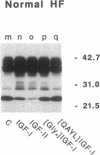Abstract
Insulin-like growth factor I and II (IGF-I and IGF-II) associate with specific IGF binding proteins (IGFBPs) present in plasma and extracellular fluids that can modulate the anabolic effects of these peptides. IGF-I has been shown to increase IGFBP concentrations in vivo and in vitro, but the mechanism and significance of this action are unknown. We examined these issues using normal and simian virus 40-transformed adult human fibroblasts (SV40-HF) in culture. Treatment with IGF-I markedly stimulated the appearance of IGFBP-3 (42/38 kD doublet), a 36 kD IGFBP, and 28-32 kD IGFBPs in the medium of these cells, as assessed by Western ligand blotting; IGF-I decreased levels of 24 kD IGFBP in normal HF cultures. The IGF-I-induced change in IGFBP levels was not a type I IGF receptor-mediated effect on IGFBP synthesis because (a) high concentrations of insulin did not mimic IGF-I's effect; (b) IGF-II and IGF-I analogues having reduced affinity for the IGF-I receptor were equipotent with IGF-I in increasing medium IGFBPs; (c) [QAYL]IGF-I, and IGF-I analogue having normal receptor affinity and decreased affinity for IGFBPs, had no effect; and (d) alpha IR-3, a monoclonal antibody specific for the type I IGF receptor, did not block IGF-I-stimulated increases in IGFBPs. In physiological studies, preincubation with 1 nM IGF-I had no effect on type I IGF receptor binding in normal HF and SV40-HF. In contrast, preincubation of cells with an equivalent concentration of [QAYL]IGF-I downregulated the receptors 40-50%. Changes in cell surface receptor number were reflected in cell responsiveness to IGF-I-stimulated [3H]thymidine incorporation and [3H]aminoisobutyric acid uptake. In conclusion, IGF-I regulates the availability of specific IGFBPs in cultured human fibroblasts by a novel receptor-independent mechanism. Rapid changes in levels of soluble IGFBPs as a direct response to extracellular IGF-I, in turn, modulate IGF-I peptide and receptor interaction, and may constitute an important level of control in IGF cellular physiology.
Full text
PDF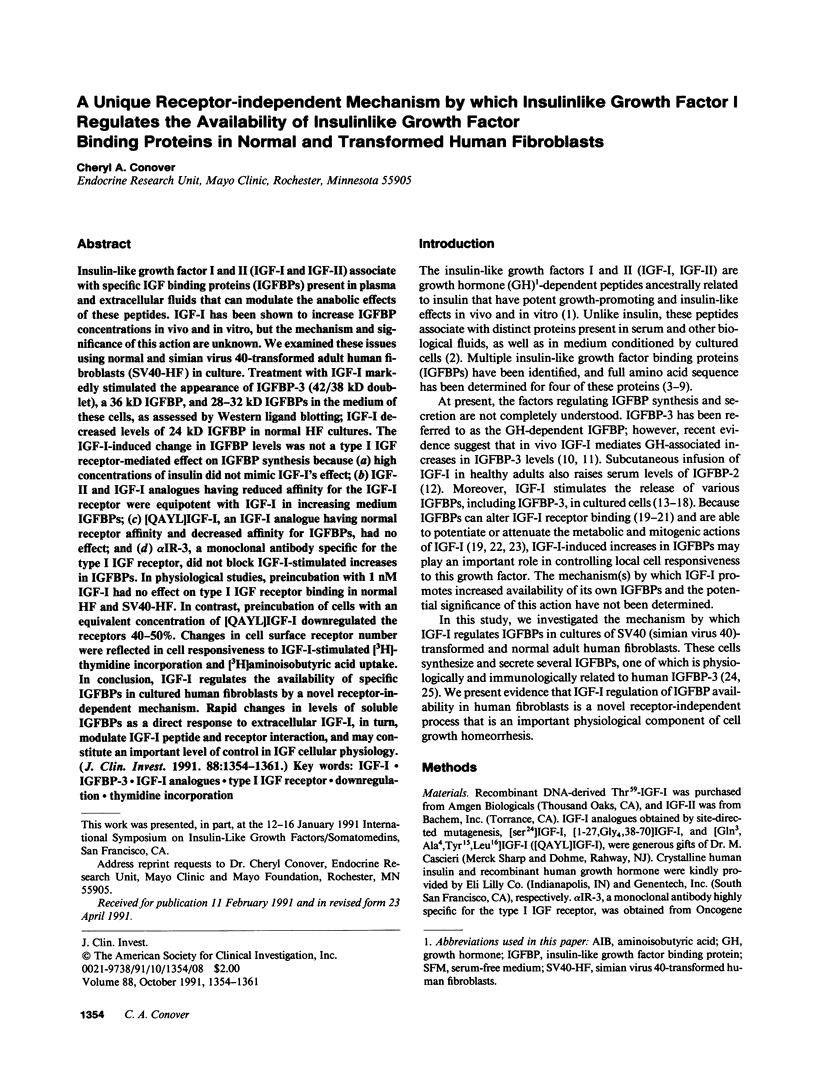
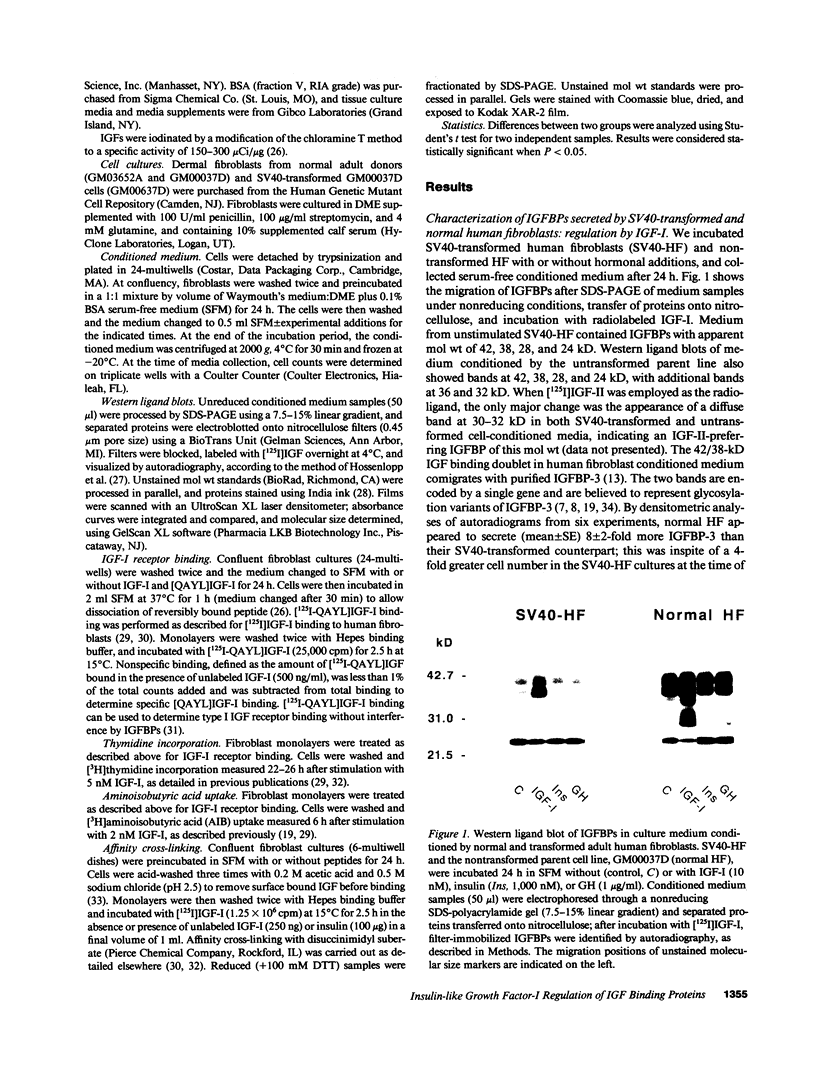
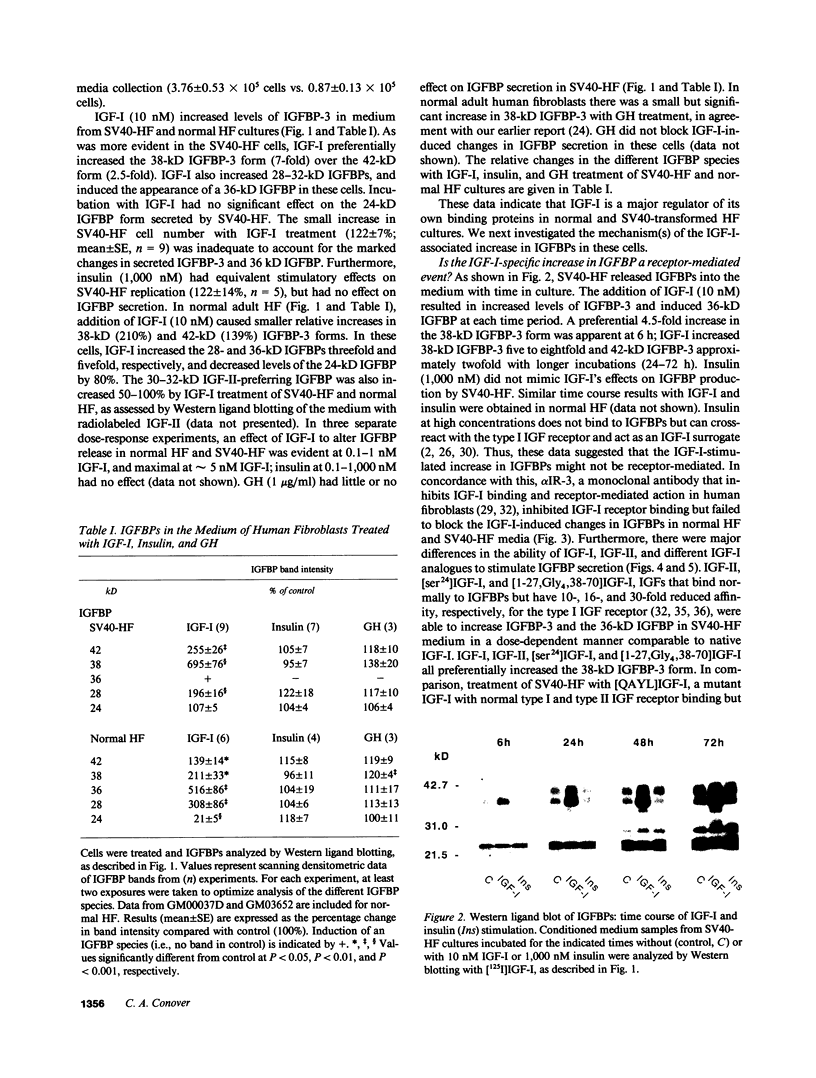
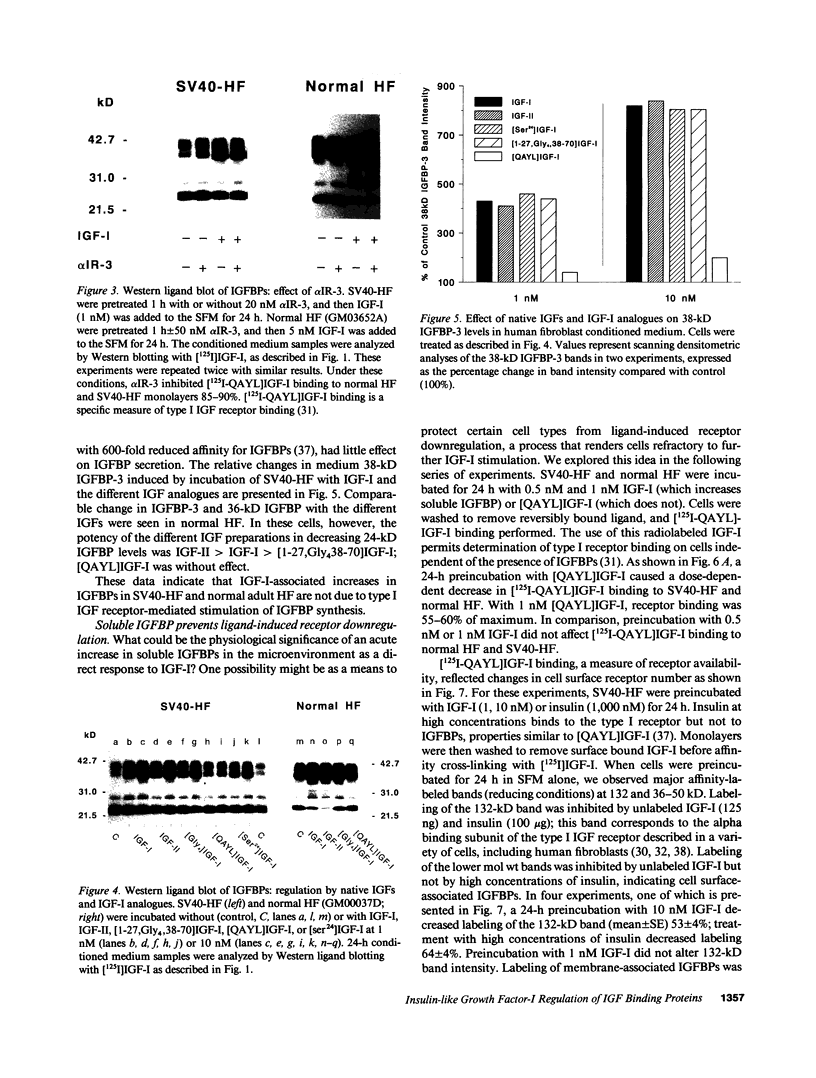
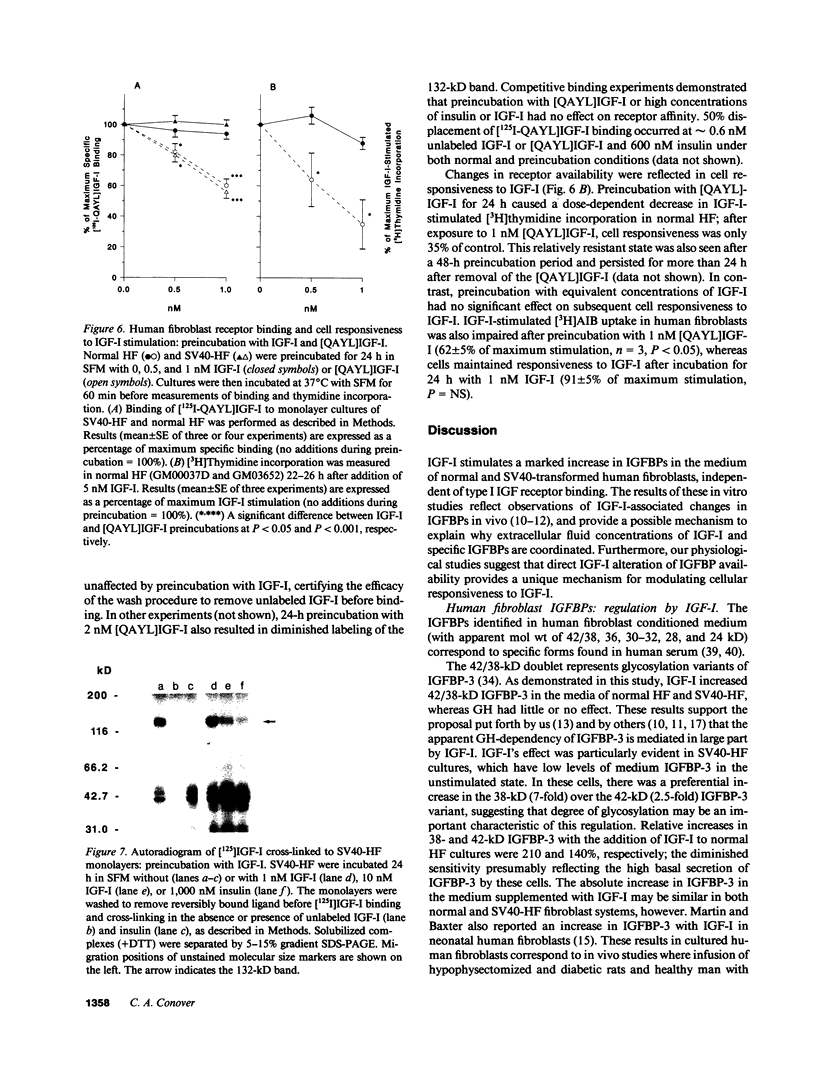
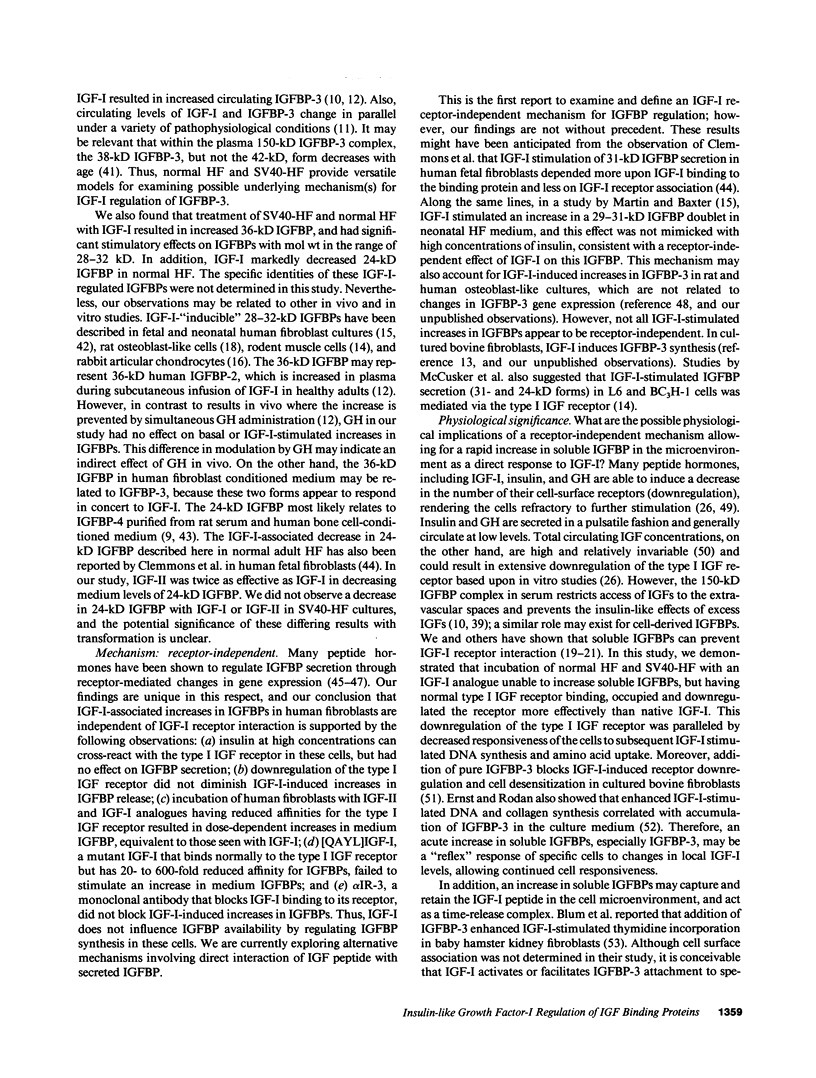
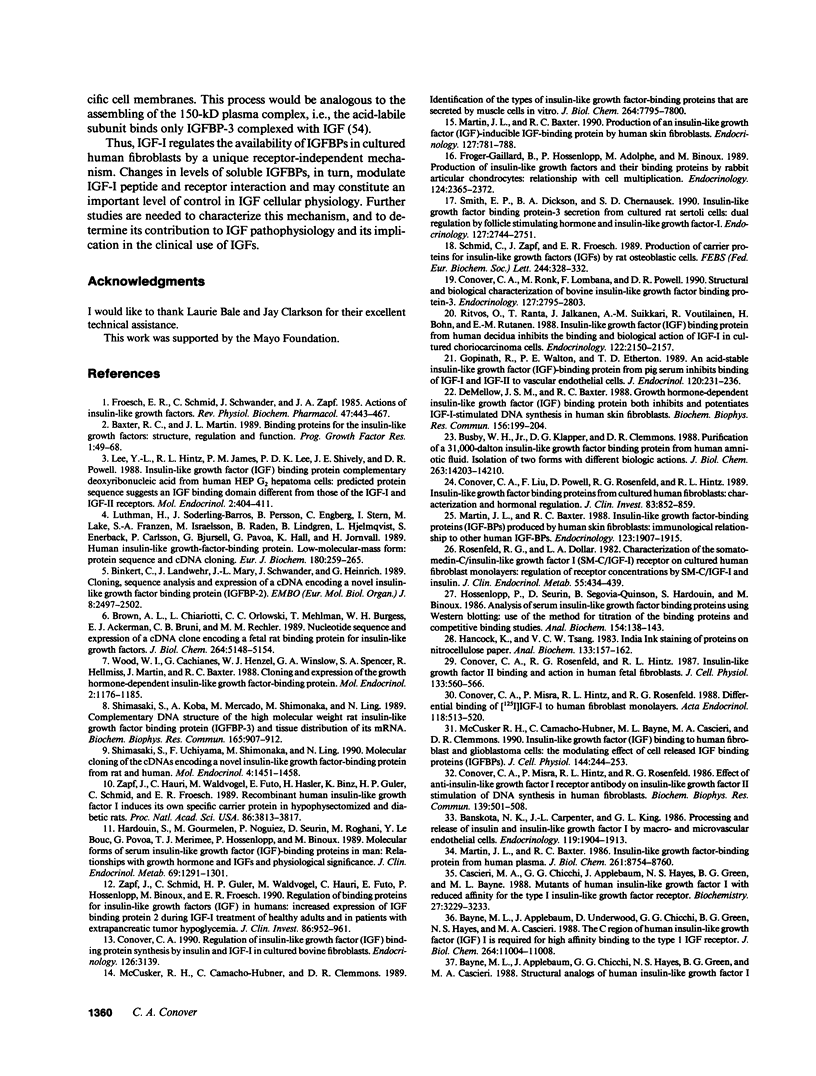
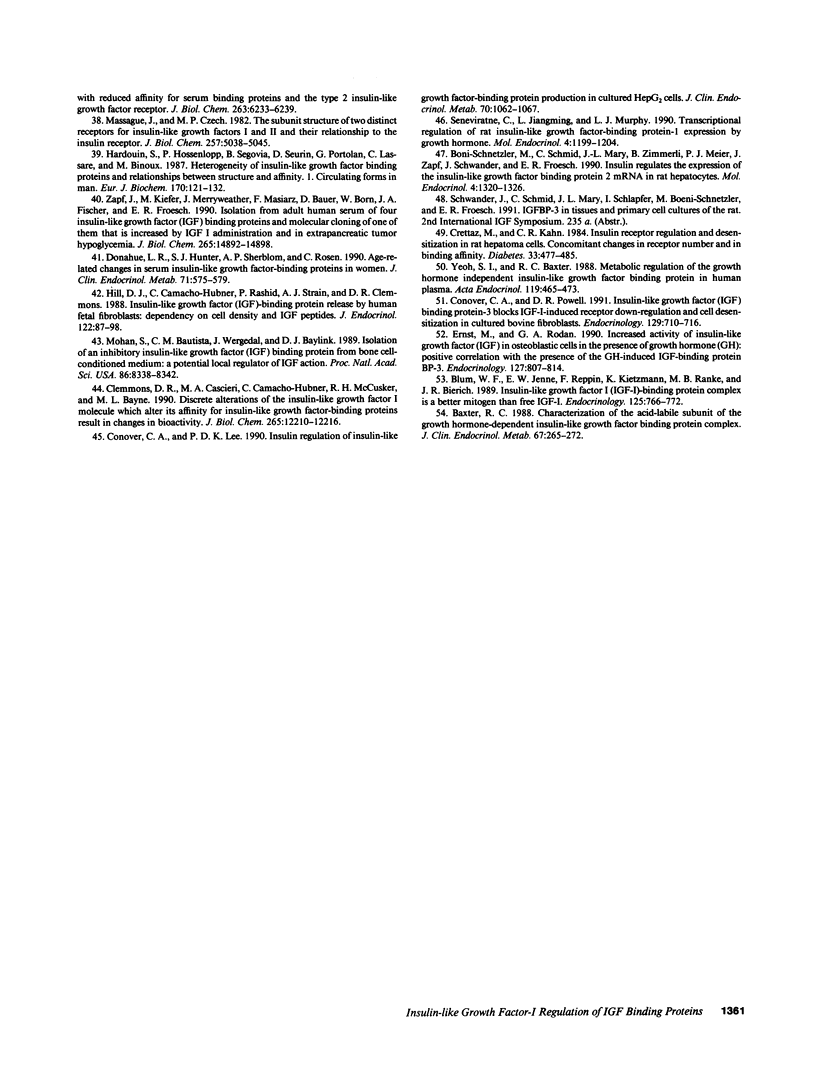
Images in this article
Selected References
These references are in PubMed. This may not be the complete list of references from this article.
- Banskota N. K., Carpentier J. L., King G. L. Processing and release of insulin and insulin-like growth factor I by macro- and microvascular endothelial cells. Endocrinology. 1986 Nov;119(5):1904–1913. doi: 10.1210/endo-119-5-1904. [DOI] [PubMed] [Google Scholar]
- Baxter R. C. Characterization of the acid-labile subunit of the growth hormone-dependent insulin-like growth factor binding protein complex. J Clin Endocrinol Metab. 1988 Aug;67(2):265–272. doi: 10.1210/jcem-67-2-265. [DOI] [PubMed] [Google Scholar]
- Baxter R. C., Martin J. L. Binding proteins for the insulin-like growth factors: structure, regulation and function. Prog Growth Factor Res. 1989;1(1):49–68. doi: 10.1016/0955-2235(89)90041-0. [DOI] [PubMed] [Google Scholar]
- Bayne M. L., Applebaum J., Chicchi G. G., Hayes N. S., Green B. G., Cascieri M. A. Structural analogs of human insulin-like growth factor I with reduced affinity for serum binding proteins and the type 2 insulin-like growth factor receptor. J Biol Chem. 1988 May 5;263(13):6233–6239. [PubMed] [Google Scholar]
- Bayne M. L., Applebaum J., Underwood D., Chicchi G. G., Green B. G., Hayes N. S., Cascieri M. A. The C region of human insulin-like growth factor (IGF) I is required for high affinity binding to the type 1 IGF receptor. J Biol Chem. 1989 Jul 5;264(19):11004–11008. [PubMed] [Google Scholar]
- Binkert C., Landwehr J., Mary J. L., Schwander J., Heinrich G. Cloning, sequence analysis and expression of a cDNA encoding a novel insulin-like growth factor binding protein (IGFBP-2). EMBO J. 1989 Sep;8(9):2497–2502. doi: 10.1002/j.1460-2075.1989.tb08386.x. [DOI] [PMC free article] [PubMed] [Google Scholar]
- Blum W. F., Jenne E. W., Reppin F., Kietzmann K., Ranke M. B., Bierich J. R. Insulin-like growth factor I (IGF-I)-binding protein complex is a better mitogen than free IGF-I. Endocrinology. 1989 Aug;125(2):766–772. doi: 10.1210/endo-125-2-766. [DOI] [PubMed] [Google Scholar]
- Brown A. L., Chiariotti L., Orlowski C. C., Mehlman T., Burgess W. H., Ackerman E. J., Bruni C. B., Rechler M. M. Nucleotide sequence and expression of a cDNA clone encoding a fetal rat binding protein for insulin-like growth factors. J Biol Chem. 1989 Mar 25;264(9):5148–5154. [PubMed] [Google Scholar]
- Busby W. H., Jr, Klapper D. G., Clemmons D. R. Purification of a 31,000-dalton insulin-like growth factor binding protein from human amniotic fluid. Isolation of two forms with different biologic actions. J Biol Chem. 1988 Oct 5;263(28):14203–14210. [PubMed] [Google Scholar]
- Böni-Schnetzler M., Schmid C., Mary J. L., Zimmerli B., Meier P. J., Zapf J., Schwander J., Froesch E. R. Insulin regulates the expression of the insulin-like growth factor binding protein 2 mRNA in rat hepatocytes. Mol Endocrinol. 1990 Sep;4(9):1320–1326. doi: 10.1210/mend-4-9-1320. [DOI] [PubMed] [Google Scholar]
- Cascieri M. A., Chicchi G. G., Applebaum J., Hayes N. S., Green B. G., Bayne M. L. Mutants of human insulin-like growth factor I with reduced affinity for the type 1 insulin-like growth factor receptor. Biochemistry. 1988 May 3;27(9):3229–3233. doi: 10.1021/bi00409a016. [DOI] [PubMed] [Google Scholar]
- Clemmons D. R., Cascieri M. A., Camacho-Hubner C., McCusker R. H., Bayne M. L. Discrete alterations of the insulin-like growth factor I molecule which alter its affinity for insulin-like growth factor-binding proteins result in changes in bioactivity. J Biol Chem. 1990 Jul 25;265(21):12210–12216. [PubMed] [Google Scholar]
- Conover C. A., Lee P. D. Insulin regulation of insulin-like growth factor-binding protein production in cultured HepG2 cells. J Clin Endocrinol Metab. 1990 Apr;70(4):1062–1067. doi: 10.1210/jcem-70-4-1062. [DOI] [PubMed] [Google Scholar]
- Conover C. A., Liu F., Powell D., Rosenfeld R. G., Hintz R. L. Insulin-like growth factor binding proteins from cultured human fibroblasts. Characterization and hormonal regulation. J Clin Invest. 1989 Mar;83(3):852–859. doi: 10.1172/JCI113968. [DOI] [PMC free article] [PubMed] [Google Scholar]
- Conover C. A., Misra P., Hintz R. L., Rosenfeld R. G. Differential binding of 125I-IGF-I preparations to human fibroblast monolayers. Acta Endocrinol (Copenh) 1988 Aug;118(4):513–520. doi: 10.1530/acta.0.1180513. [DOI] [PubMed] [Google Scholar]
- Conover C. A., Misra P., Hintz R. L., Rosenfeld R. G. Effect of an anti-insulin-like growth factor I receptor antibody on insulin-like growth factor II stimulation of DNA synthesis in human fibroblasts. Biochem Biophys Res Commun. 1986 Sep 14;139(2):501–508. doi: 10.1016/s0006-291x(86)80019-5. [DOI] [PubMed] [Google Scholar]
- Conover C. A., Powell D. R. Insulin-like growth factor (IGF)-binding protein-3 blocks IGF-I-induced receptor down-regulation and cell desensitization in cultured bovine fibroblasts. Endocrinology. 1991 Aug;129(2):710–716. doi: 10.1210/endo-129-2-710. [DOI] [PubMed] [Google Scholar]
- Conover C. A. Regulation of insulin-like growth factor (IGF)-binding protein synthesis by insulin and IGF-I in cultured bovine fibroblasts. Endocrinology. 1990 Jun;126(6):3139–3145. doi: 10.1210/endo-126-6-3139. [DOI] [PubMed] [Google Scholar]
- Conover C. A., Ronk M., Lombana F., Powell D. R. Structural and biological characterization of bovine insulin-like growth factor binding protein-3. Endocrinology. 1990 Dec;127(6):2795–2803. doi: 10.1210/endo-127-6-2795. [DOI] [PubMed] [Google Scholar]
- Conover C. A., Rosenfeld R. G., Hintz R. L. Insulin-like growth factor II binding and action in human fetal fibroblasts. J Cell Physiol. 1987 Dec;133(3):560–566. doi: 10.1002/jcp.1041330318. [DOI] [PubMed] [Google Scholar]
- Crettaz M., Kahn C. R. Insulin receptor regulation and desensitization in rat hepatoma cells. Concomitant changes in receptor number and in binding affinity. Diabetes. 1984 May;33(5):477–485. doi: 10.2337/diab.33.5.477. [DOI] [PubMed] [Google Scholar]
- De Mellow J. S., Baxter R. C. Growth hormone-dependent insulin-like growth factor (IGF) binding protein both inhibits and potentiates IGF-I-stimulated DNA synthesis in human skin fibroblasts. Biochem Biophys Res Commun. 1988 Oct 14;156(1):199–204. doi: 10.1016/s0006-291x(88)80824-6. [DOI] [PubMed] [Google Scholar]
- Donahue L. R., Hunter S. J., Sherblom A. P., Rosen C. Age-related changes in serum insulin-like growth factor-binding proteins in women. J Clin Endocrinol Metab. 1990 Sep;71(3):575–579. doi: 10.1210/jcem-71-3-575. [DOI] [PubMed] [Google Scholar]
- Ernst M., Rodan G. A. Increased activity of insulin-like growth factor (IGF) in osteoblastic cells in the presence of growth hormone (GH): positive correlation with the presence of the GH-induced IGF-binding protein BP-3. Endocrinology. 1990 Aug;127(2):807–814. doi: 10.1210/endo-127-2-807. [DOI] [PubMed] [Google Scholar]
- Froesch E. R., Schmid C., Schwander J., Zapf J. Actions of insulin-like growth factors. Annu Rev Physiol. 1985;47:443–467. doi: 10.1146/annurev.ph.47.030185.002303. [DOI] [PubMed] [Google Scholar]
- Froger-Gaillard B., Hossenlopp P., Adolphe M., Binoux M. Production of insulin-like growth factors and their binding proteins by rabbit articular chondrocytes: relationships with cell multiplication. Endocrinology. 1989 May;124(5):2365–2372. doi: 10.1210/endo-124-5-2365. [DOI] [PubMed] [Google Scholar]
- Gopinath R., Walton P. E., Etherton T. D. An acid-stable insulin-like growth factor (IGF)-binding protein from pig serum inhibits binding of IGF-I and IGF-II to vascular endothelial cells. J Endocrinol. 1989 Feb;120(2):231–236. doi: 10.1677/joe.0.1200231. [DOI] [PubMed] [Google Scholar]
- Hancock K., Tsang V. C. India ink staining of proteins on nitrocellulose paper. Anal Biochem. 1983 Aug;133(1):157–162. doi: 10.1016/0003-2697(83)90237-3. [DOI] [PubMed] [Google Scholar]
- Hardouin S., Gourmelen M., Noguiez P., Seurin D., Roghani M., Le Bouc Y., Povoa G., Merimee T. J., Hossenlopp P., Binoux M. Molecular forms of serum insulin-like growth factor (IGF)-binding proteins in man: relationships with growth hormone and IGFs and physiological significance. J Clin Endocrinol Metab. 1989 Dec;69(6):1291–1301. doi: 10.1210/jcem-69-6-1291. [DOI] [PubMed] [Google Scholar]
- Hardouin S., Hossenlopp P., Segovia B., Seurin D., Portolan G., Lassarre C., Binoux M. Heterogeneity of insulin-like growth factor binding proteins and relationships between structure and affinity. 1. Circulating forms in man. Eur J Biochem. 1987 Dec 30;170(1-2):121–132. doi: 10.1111/j.1432-1033.1987.tb13676.x. [DOI] [PubMed] [Google Scholar]
- Hill D. J., Camacho-Hubner C., Rashid P., Strain A. J., Clemmons D. R. Insulin-like growth factor (IGF)-binding protein release by human fetal fibroblasts: dependency on cell density and IGF peptides. J Endocrinol. 1989 Jul;122(1):87–98. doi: 10.1677/joe.0.1220087. [DOI] [PubMed] [Google Scholar]
- Hossenlopp P., Seurin D., Segovia-Quinson B., Hardouin S., Binoux M. Analysis of serum insulin-like growth factor binding proteins using western blotting: use of the method for titration of the binding proteins and competitive binding studies. Anal Biochem. 1986 Apr;154(1):138–143. doi: 10.1016/0003-2697(86)90507-5. [DOI] [PubMed] [Google Scholar]
- Lee Y. L., Hintz R. L., James P. M., Lee P. D., Shively J. E., Powell D. R. Insulin-like growth factor (IGF) binding protein complementary deoxyribonucleic acid from human HEP G2 hepatoma cells: predicted protein sequence suggests an IGF binding domain different from those of the IGF-I and IGF-II receptors. Mol Endocrinol. 1988 May;2(5):404–411. doi: 10.1210/mend-2-5-404. [DOI] [PubMed] [Google Scholar]
- Luthman H., Söderling-Barros J., Persson B., Engberg C., Stern I., Lake M., Franzén S. A., Israelsson M., Rådén B., Lindgren B. Human insulin-like growth-factor-binding protein. Low-molecular-mass form: protein sequence and cDNA cloning. Eur J Biochem. 1989 Mar 15;180(2):259–265. doi: 10.1111/j.1432-1033.1989.tb14641.x. [DOI] [PubMed] [Google Scholar]
- Martin J. L., Baxter R. C. Insulin-like growth factor-binding protein from human plasma. Purification and characterization. J Biol Chem. 1986 Jul 5;261(19):8754–8760. [PubMed] [Google Scholar]
- Martin J. L., Baxter R. C. Insulin-like growth factor-binding proteins (IGF-BPs) produced by human skin fibroblasts: immunological relationship to other human IGF-BPs. Endocrinology. 1988 Oct;123(4):1907–1915. doi: 10.1210/endo-123-4-1907. [DOI] [PubMed] [Google Scholar]
- Martin J. L., Baxter R. C. Production of an insulin-like growth factor (IGF)-inducible IGF-binding protein by human skin fibroblasts. Endocrinology. 1990 Aug;127(2):781–788. doi: 10.1210/endo-127-2-781. [DOI] [PubMed] [Google Scholar]
- Massagué J., Czech M. P. The subunit structures of two distinct receptors for insulin-like growth factors I and II and their relationship to the insulin receptor. J Biol Chem. 1982 May 10;257(9):5038–5045. [PubMed] [Google Scholar]
- McCusker R. H., Camacho-Hubner C., Bayne M. L., Cascieri M. A., Clemmons D. R. Insulin-like growth factor (IGF) binding to human fibroblast and glioblastoma cells: the modulating effect of cell released IGF binding proteins (IGFBPs). J Cell Physiol. 1990 Aug;144(2):244–253. doi: 10.1002/jcp.1041440210. [DOI] [PubMed] [Google Scholar]
- McCusker R. H., Camacho-Hübner C., Clemmons D. R. Identification of the types of insulin-like growth factor-binding proteins that are secreted by muscle cells in vitro. J Biol Chem. 1989 May 15;264(14):7795–7800. [PubMed] [Google Scholar]
- Mohan S., Bautista C. M., Wergedal J., Baylink D. J. Isolation of an inhibitory insulin-like growth factor (IGF) binding protein from bone cell-conditioned medium: a potential local regulator of IGF action. Proc Natl Acad Sci U S A. 1989 Nov;86(21):8338–8342. doi: 10.1073/pnas.86.21.8338. [DOI] [PMC free article] [PubMed] [Google Scholar]
- Ritvos O., Ranta T., Jalkanen J., Suikkari A. M., Voutilainen R., Bohn H., Rutanen E. M. Insulin-like growth factor (IGF) binding protein from human decidua inhibits the binding and biological action of IGF-I in cultured choriocarcinoma cells. Endocrinology. 1988 May;122(5):2150–2157. doi: 10.1210/endo-122-5-2150. [DOI] [PubMed] [Google Scholar]
- Rosenfeld R. G., Dollar L. A. Characterization of the somatomedin-C/insulin-like growth factor I (SM-C/IGF-I) receptor on cultured human fibroblast monolayers: regulation of receptor concentrations by SM-C/IGF-I and insulin. J Clin Endocrinol Metab. 1982 Sep;55(3):434–440. doi: 10.1210/jcem-55-3-434. [DOI] [PubMed] [Google Scholar]
- Schmid C., Zapf J., Froesch E. R. Production of carrier proteins for insulin-like growth factors (IGFs) by rat osteoblastic cells. Regulation by IGF I and cortisol. FEBS Lett. 1989 Feb 27;244(2):328–332. doi: 10.1016/0014-5793(89)80556-3. [DOI] [PubMed] [Google Scholar]
- Seneviratne C., Luo J. M., Murphy L. J. Transcriptional regulation of rat insulin-like growth factor-binding protein-1 expression by growth hormone. Mol Endocrinol. 1990 Aug;4(8):1199–1204. doi: 10.1210/mend-4-8-1199. [DOI] [PubMed] [Google Scholar]
- Shimasaki S., Koba A., Mercado M., Shimonaka M., Ling N. Complementary DNA structure of the high molecular weight rat insulin-like growth factor binding protein (IGF-BP3) and tissue distribution of its mRNA. Biochem Biophys Res Commun. 1989 Dec 15;165(2):907–912. doi: 10.1016/s0006-291x(89)80052-x. [DOI] [PubMed] [Google Scholar]
- Shimasaki S., Uchiyama F., Shimonaka M., Ling N. Molecular cloning of the cDNAs encoding a novel insulin-like growth factor-binding protein from rat and human. Mol Endocrinol. 1990 Oct;4(10):1451–1458. doi: 10.1210/mend-4-10-1451. [DOI] [PubMed] [Google Scholar]
- Smith E. P., Dickson B. A., Chernausek S. D. Insulin-like growth factor binding protein-3 secretion from cultured rat sertoli cells: dual regulation by follicle stimulating hormone and insulin-like growth factor-I. Endocrinology. 1990 Dec;127(6):2744–2751. doi: 10.1210/endo-127-6-2744. [DOI] [PubMed] [Google Scholar]
- Wood W. I., Cachianes G., Henzel W. J., Winslow G. A., Spencer S. A., Hellmiss R., Martin J. L., Baxter R. C. Cloning and expression of the growth hormone-dependent insulin-like growth factor-binding protein. Mol Endocrinol. 1988 Dec;2(12):1176–1185. doi: 10.1210/mend-2-12-1176. [DOI] [PubMed] [Google Scholar]
- Yeoh S. I., Baxter R. C. Metabolic regulation of the growth hormone independent insulin-like growth factor binding protein in human plasma. Acta Endocrinol (Copenh) 1988 Dec;119(4):465–473. doi: 10.1530/acta.0.1190465. [DOI] [PubMed] [Google Scholar]
- Zapf J., Hauri C., Waldvogel M., Futo E., Häsler H., Binz K., Guler H. P., Schmid C., Froesch E. R. Recombinant human insulin-like growth factor I induces its own specific carrier protein in hypophysectomized and diabetic rats. Proc Natl Acad Sci U S A. 1989 May;86(10):3813–3817. doi: 10.1073/pnas.86.10.3813. [DOI] [PMC free article] [PubMed] [Google Scholar]
- Zapf J., Kiefer M., Merryweather J., Musiarz F., Bauer D., Born W., Fischer J. A., Froesch E. R. Isolation from adult human serum of four insulin-like growth factor (IGF) binding proteins and molecular cloning of one of them that is increased by IGF I administration and in extrapancreatic tumor hypoglycemia. J Biol Chem. 1990 Sep 5;265(25):14892–14898. [PubMed] [Google Scholar]
- Zapf J., Schmid C., Guler H. P., Waldvogel M., Hauri C., Futo E., Hossenlopp P., Binoux M., Froesch E. R. Regulation of binding proteins for insulin-like growth factors (IGF) in humans. Increased expression of IGF binding protein 2 during IGF I treatment of healthy adults and in patients with extrapancreatic tumor hypoglycemia. J Clin Invest. 1990 Sep;86(3):952–961. doi: 10.1172/JCI114797. [DOI] [PMC free article] [PubMed] [Google Scholar]






